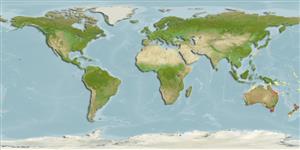Environment: milieu / climate zone / depth range / distribution range
Écologie
marin récifal; profondeur 0 - 10 m (Ref. 57886). Temperate
Southwest Pacific: Australia and New Zealand.
Taille / Poids / Âge
Maturity: Lm ? range ? - ? cm
Max length : 10.0 cm TL mâle / non sexé; (Ref. 30464); 7.3 cm SL (female); common length : 8.0 cm TL mâle / non sexé; (Ref. 30464)
A common, secretive species of inshore reefs (Ref. 34024). Lives on rocky shores, often buried in sand, mud or silt below stones or other hard substrate. Specimens in collections often had medium to coarse grained quartz sand trapped in the gill opening (a sand-bottom adaptation and might explain why it is so rarely caught together with D. hoesei, even though both species live in the same general area of south-eastern Australia Depths down to 5 m. A female specimen (AMS I.16469-016, 62 mm SL ) was found to contain two pale unpigmented embryos, 6-7 mm SL. Maximum length for female taken from Ref. 57886.
Life cycle and mating behavior
Maturité | Reproduction | Frai | Œufs | Fécondité | Larves
Møller, P.R. and W. Schwarzhans, 2006. Review of the Dinematichthyini (Teleostei, Bythitidae) of the Indo-west Pacific, Part II. Dermatopsis, Dermatopsoides and Dipulus with description of six new species. The Beagle 22:39-76. (Ref. 57886)
Statut dans la liste rouge de l'IUCN (Ref. 130435: Version 2024-2)
Menace pour l'homme
Harmless
Utilisations par l'homme
Pêcheries: sans intérêt
Outils
Articles particuliers
Télécharger en XML
Sources Internet
Estimates based on models
Preferred temperature (Ref.
123201): 15.3 - 27.2, mean 23.3 °C (based on 731 cells).
Phylogenetic diversity index (Ref.
82804): PD
50 = 0.5312 [Uniqueness, from 0.5 = low to 2.0 = high].
Bayesian length-weight: a=0.00389 (0.00180 - 0.00842), b=3.12 (2.94 - 3.30), in cm total length, based on all LWR estimates for this body shape (Ref.
93245).
Niveau trophique (Ref.
69278): 3.3 ±0.5 se; based on size and trophs of closest relatives
Résilience (Ref.
120179): Faible, temps minimum de doublement de population : 4,5 à 14 années (Assuming Fec < 100).
Fishing Vulnerability (Ref.
59153): Low vulnerability (10 of 100).
